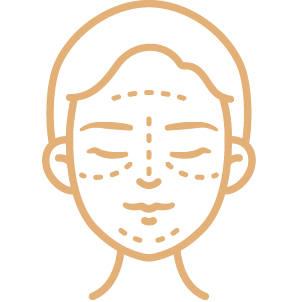Centrally located in Southampton, PA and serving Philadelphia, Bucks, and Montgomery Counties, The Kole Plastic Surgery Center performs chin implants for patients desiring plastic surgery.
Surgical implants for the chin can modify the structure of the face to present a more pleasing balance to your features. These implants are often inserted at the time of another cosmetic procedure, such as a rhinoplasty. In recent years, the fastest-growing area of facial cosmetic surgery has been the choice to have chin implants.
Chin implants are custom implants used for a variety of aesthetic reasons. In younger patients, implants are used to bring certain features into cosmetic balance with of the rest of your face. In older patients, they are utilized to restore a more youthful contour to the face, especially in conjunction with facelift surgery. Dr. Kole can use chin implants to improve balance and enhance your facial features resulting in better symmetry, balance, and feelings about your appearance.
A variety of chin implants are available in different sizes, shapes, contours, and materials. Most of the time, patients opt for implants made of solid, non-leaking silicone material. However, numerous options are available for implant materials, ranging from biocompatible manmade materials to harvesting your own bone. During your initial consultation, Dr. Kole will work with you to determine precisely the areas of concern and which implants will work to achieve your desired cosmetic results.
Implants are available for the chin for patients with weak chins. These implants are also available in a cleft variety to achieve a cleft chin when one was not born that way. Patients choose a chin implant to gain an improved facial profile and more attractive jaw line. Frequently when choosing chin implant surgery, many patients also decide to have other cosmetic surgery procedures performed.
Placement of the chin implant is done as an outpatient procedure in our private, licensed surgical center performed under local anesthesia with light sedation. The incision for chin implants is usually done through an incision in the lower lip sulcus under the level of the teeth and gums. Dr. Kole prefers this technique to avoid an external visible scar on the chin. After the procedure, ice packs are applied to the surgical site to minimize discomfort and swelling. The entire surgical procedure, when performed alone, takes less than one hour.
You will experience some minor discomfort after surgery. Any bruising and swelling in the affected area will diminish over the next several days. Dr. Kole will give you very detailed postoperative instructions for your care, as well as restrictions on diet and exercise. Swelling will gradually subside over approximately two weeks; your newly contoured face will emerge and become more defined as the swelling subsides. Most people will be unable to tell that you have had facial surgery. However, they will notice that you look better, especially as you become more confident with your improved look.
Implants can correct or improve your appearance in subtle ways. You can expect that people will find your face to be more balanced and symmetrical after surgery.
The price of a chin implant varies for each person. The cost depends on the extent of surgery necessary to achieve your individual appearance goal.
The Kole Plastic Surgery Center Center accepts cash, check, and credit card (MasterCard®, Visa®, American Express®, Discover®) as acceptable forms of payment.
Financing is also available through CareCredit®, United Medical Credit and Advanced Care.


Do you have an underdefined chin? Does it look as if something is missing when you look at your profile? You may be a good candidate for chin implants by board certified plastic surgeon, Dr. Kole. He works with men and women in Southampton, PA, Philadelphia County, Bucks County, Montgomery County and surrounding areas of Bucks County, PA, who are like you and want to improve their facial balance. To learn more about chin implants, contact us to schedule a personal consultation.

215-315-7655
Kole Plastic Surgery Center
We firmly believe that the internet should be available and accessible to anyone, and are committed to providing a website that is accessible to the widest possible audience, regardless of circumstance and ability.
To fulfill this, we aim to adhere as strictly as possible to the World Wide Web Consortium’s (W3C) Web Content Accessibility Guidelines 2.1 (WCAG 2.1) at the AA level. These guidelines explain how to make web content accessible to people with a wide array of disabilities. Complying with those guidelines helps us ensure that the website is accessible to all people: blind people, people with motor impairments, visual impairment, cognitive disabilities, and more.
This website utilizes various technologies that are meant to make it as accessible as possible at all times. We utilize an accessibility interface that allows persons with specific disabilities to adjust the website’s UI (user interface) and design it to their personal needs.
Additionally, the website utilizes an AI-based application that runs in the background and optimizes its accessibility level constantly. This application remediates the website’s HTML, adapts Its functionality and behavior for screen-readers used by the blind users, and for keyboard functions used by individuals with motor impairments.
If you’ve found a malfunction or have ideas for improvement, we’ll be happy to hear from you. You can reach out to the website’s operators by using the following email
Our website implements the ARIA attributes (Accessible Rich Internet Applications) technique, alongside various different behavioral changes, to ensure blind users visiting with screen-readers are able to read, comprehend, and enjoy the website’s functions. As soon as a user with a screen-reader enters your site, they immediately receive a prompt to enter the Screen-Reader Profile so they can browse and operate your site effectively. Here’s how our website covers some of the most important screen-reader requirements, alongside console screenshots of code examples:
Screen-reader optimization: we run a background process that learns the website’s components from top to bottom, to ensure ongoing compliance even when updating the website. In this process, we provide screen-readers with meaningful data using the ARIA set of attributes. For example, we provide accurate form labels; descriptions for actionable icons (social media icons, search icons, cart icons, etc.); validation guidance for form inputs; element roles such as buttons, menus, modal dialogues (popups), and others. Additionally, the background process scans all the website’s images and provides an accurate and meaningful image-object-recognition-based description as an ALT (alternate text) tag for images that are not described. It will also extract texts that are embedded within the image, using an OCR (optical character recognition) technology. To turn on screen-reader adjustments at any time, users need only to press the Alt+1 keyboard combination. Screen-reader users also get automatic announcements to turn the Screen-reader mode on as soon as they enter the website.
These adjustments are compatible with all popular screen readers, including JAWS and NVDA.
Keyboard navigation optimization: The background process also adjusts the website’s HTML, and adds various behaviors using JavaScript code to make the website operable by the keyboard. This includes the ability to navigate the website using the Tab and Shift+Tab keys, operate dropdowns with the arrow keys, close them with Esc, trigger buttons and links using the Enter key, navigate between radio and checkbox elements using the arrow keys, and fill them in with the Spacebar or Enter key.Additionally, keyboard users will find quick-navigation and content-skip menus, available at any time by clicking Alt+1, or as the first elements of the site while navigating with the keyboard. The background process also handles triggered popups by moving the keyboard focus towards them as soon as they appear, and not allow the focus drift outside it.
Users can also use shortcuts such as “M” (menus), “H” (headings), “F” (forms), “B” (buttons), and “G” (graphics) to jump to specific elements.
We aim to support the widest array of browsers and assistive technologies as possible, so our users can choose the best fitting tools for them, with as few limitations as possible. Therefore, we have worked very hard to be able to support all major systems that comprise over 95% of the user market share including Google Chrome, Mozilla Firefox, Apple Safari, Opera and Microsoft Edge, JAWS and NVDA (screen readers).
Despite our very best efforts to allow anybody to adjust the website to their needs. There may still be pages or sections that are not fully accessible, are in the process of becoming accessible, or are lacking an adequate technological solution to make them accessible. Still, we are continually improving our accessibility, adding, updating and improving its options and features, and developing and adopting new technologies. All this is meant to reach the optimal level of accessibility, following technological advancements. For any assistance, please reach out to
chin augmentation philadelphia, jaw augmentation feasterville pa, chin implants philadelphia, cheek implants philadelphia, facial implants philadelphia
This section provides a comprehensive overview of the chin implant procedure, including the purpose, surgical steps, and expected outcomes. It explains how chin implants can enhance facial balance and aesthetics for both men and women.
The chin implant procedure involves carefully placing a custom-designed implant beneath the skin to augment the chin and create a more defined, proportional facial profile. Patients can choose from a variety of implant sizes, shapes, and materials to achieve their desired look. Recovery typically takes 1-2 weeks, with minimal downtime and discomfort.
This section discusses the factors that make someone a good candidate for chin implants, such as facial structure, symmetry, and personal aesthetic goals. It also outlines the consultation process, where patients can discuss their concerns and work with the surgeon to develop a personalized treatment plan.
During the consultation, the surgeon will evaluate the patient's facial features, take measurements, and provide recommendations on the optimal implant size and placement. This collaborative approach ensures the patient achieves natural-looking, balanced results that align with their desired outcome.
This section covers the post-operative recovery process for chin implant surgery, including what patients can expect in terms of swelling, bruising, and activity restrictions. It also provides guidance on proper aftercare and follow-up appointments to ensure a smooth healing process and long-lasting results.
Patients can typically return to work and their normal daily activities within 1-2 weeks after the procedure, though strenuous exercise may be limited for several weeks. The surgeon will provide detailed instructions on caring for the surgical site, managing any discomfort, and when to schedule follow-up visits to monitor the patient's progress.
This section discusses the average cost of chin implant surgery, including factors that may influence the final price, such as the surgeon's experience, geographic location, and the complexity of the procedure. It also outlines the various financing options available to help make the procedure more accessible.
The Kole Plastic Surgery Center offers a range of payment plans and financing programs to suit different budgets, including credit card payments, CareCredit, and in-house financing. The team is committed to providing transparent pricing and helping patients explore the best options to achieve their aesthetic goals.